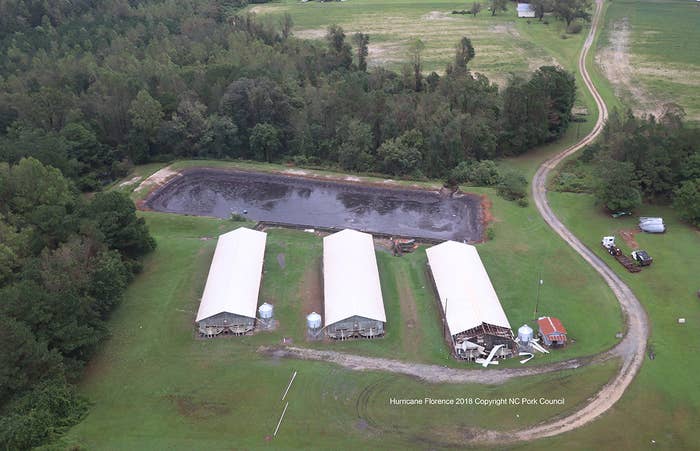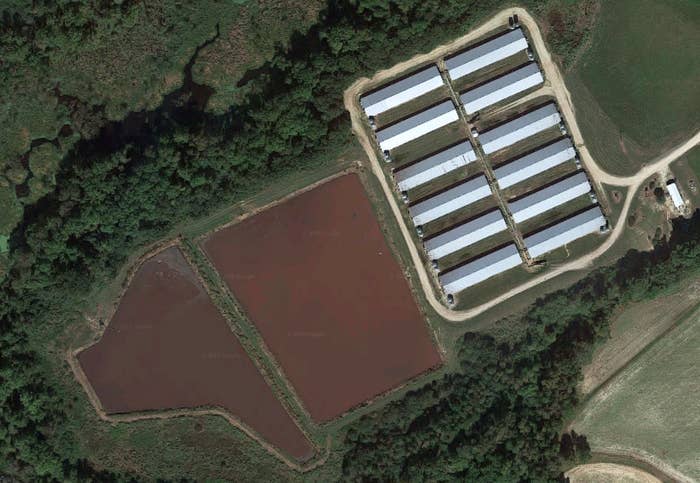
Flooding after Florence has caused hog poop lagoons in North Carolina to breach and overflow, carrying away raw excrement, harmful bacteria, and chemicals. Experts say the pathogens could make people ill, and the pinkish sludge could spur an abundance of algal blooms and kill fish in rivers.
Hog farm “lagoons” are lined pits that hold hog poop and urine — both nitrogen-rich wastes — before spraying or distributing them through irrigation channels as fertilizer. North Carolina is the second-largest hog farming state in the country after Iowa, and with about 9 million pigs accounts for roughly 13% of the country’s inventory.
By noon on Tuesday, two farms reported to the North Carolina Department of Environmental Quality that lagoons had broken and breached, and two others reported structural damage of some sort. Thirteen other sites reported that there was hog waste flowing away, and nearly 40 reported being full or nearly so.
The agency has not conducted inspections so far because the roads leading to the sites were flooded, spokesperson Tricia Smith told BuzzFeed News in an email. According to the DEQ, there are 3,300 hog waste lagoons in the state.
Past hurricanes have brought similar chaos, drenching farmland and alarming public health officials. Most notably, Hurricane Floyd in 1999 caused massive overflows, with farm wastes expected to seep into the water supply into the following spring, the New York Times reported at the time. After Hurricane Matthew in 2016, at least 14 lagoons overflowed.
Last week as Florence approached, some farms drained lagoons in preparation for the storm, spraying the liquid on the fields, and many have been taking such steps since August, John Classen, associate professor of biological and agricultural engineering at North Carolina State University, told BuzzFeed News. “They’ve had a lot of capacity for rain and that’s why more lagoons are not overflowing now,” Classen said.
On Tuesday, the North Carolina Pork Council said that it did not expect serious impacts to most farms, but expected additional reports to emerge after the flooding receded.
Water flowing over the top of the structures is a major concern because they are made of soil and not designed to be eroded from the top, Classen said. According to the DEQ, 81 structures were experiencing such “over-topping,” or were inches away from it. “That could put pressure on the dam and it could fail,” Classen said.

The qualities that make hog waste an attractive fertilizer also pose a threat to freshwater and the estuaries it may flood into, Rachel Noble, professor of environmental microbiology at the Department of Marine Sciences at the University of North Carolina at Chapel Hill, told BuzzFeed News.
The sludge, rich in both phosphate and nitrogen, is basically plant food, so with sunlight hitting the water bodies, “we would not be surprised to see very rapid algae growth,” Noble said. The bacterial growth that follows the bloom uses up the oxygen in water and can kill fish.
Meanwhile, E. coli, campylobacter, and salmonella bacteria in the runoff could contaminate private drinking water wells. “The floodwaters make it so that everything is connected — water in these situations knows no boundaries,” Noble said.
Lagoons are a cost-effective and efficient way to use hog feces, Daniel Andersen, assistant professor of agriculture and biosystems engineering at Iowa State University, told BuzzFeed News. They’re most effective in warmer states, he said — in Iowa, on the other hand, “the lagoon is going to freeze in the winter.”
But the structures have long been controversial. Nearby communities have fought their construction because of the smell and concerns that they will leach contaminants into the groundwater and water table.
North Carolina is in the unique position of hosting lagoons, while also facing intermittent flooding threats from bad hurricanes. “I can’t think of anyone who would be in the same situation,” Andersen said.
UPDATE
This article was updated to clarify how fish die after an algal bloom.

